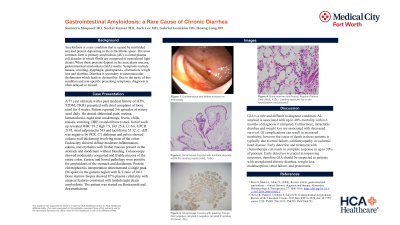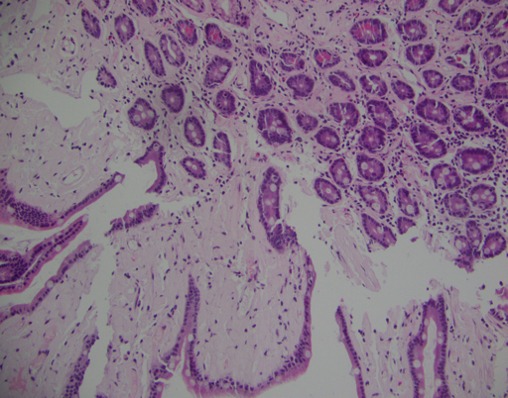Monday Poster Session
Category: Small Intestine
P2692 - Gastrointestinal Amyloidosis: A Rare Cause of Chronic Diarrhea
Monday, October 23, 2023
10:30 AM - 4:15 PM PT
Location: Exhibit Hall

Has Audio

Sameera M. Muqueet, DO
Medical City Fort Worth
Euless, TX
Presenting Author(s)
Sameera M. Muqueet, DO1, Neetal Kumar, MD1, Jack Lee, MD1, Gabriel Gonzales, DO1, Long T. Hoang, DO2
1Medical City Fort Worth, Fort Worth, TX; 2UNT Health, Fort Worth, TX
Introduction: Amyloidosis is a rare condition that is caused by misfolded amyloid protein depositing in the extracellular space. The most common form is primary amyloidosis (AL), a clonal plasma cell disorder in which fibrils are composed of monoclonal light chains. When these proteins deposit in the muscularis mucosa, gastrointestinal amyloidosis (GIA) results. Symptoms include nausea, vomiting, dysphagia, gastroparesis, obstruction, weight loss and diarrhea. Diarrhea is secondary to neuromuscular dysfunction which leads to dysmotility. Due to the rarity of this condition and non-specific presenting symptoms, diagnosis is often delayed or missed.
Case Description/Methods: A 77 year old male with a past medical history of HTN, T2DM, CKD3 presented with chief complaint of loose stool for 4 weeks. Patient reported 5-6 episodes of watery stool daily. He denied abdominal pain, melena, hematochezia, night time awakenings, fevers, chills, nausea, vomiting. DRE revealed brown stool. Initial work up revealed WBC 19.2 Hgb 7.9, Hct 25.4, Cr 6.6, UPCR 2195, stool calprotectin 543 and lactoferrin 55.32. C. diff was negative by PCR. CT abdomen and pelvis showed colonic wall thickening involving most of the colon. Endoscopy showed diffuse moderate inflammation, edema, and erythema with friable mucosa present in the stomach and duodenum without bleeding. Colonoscopy showed moderately congested and friable mucosa of the entire colon. Gastric and bowel pathology were positive for amyloidosis of the stomach and duodenum. Protein electrophoresis interpretation demonstrated a single peak (M-spike) in the gamma region with K/L ratio of 0.01. Bone marrow biopsy showed 87% plasma cellularity with atypical features consistent with lambda light chain amyloidosis. The patient was started on Bortezomib and decadron.
Discussion: GIA is a rare and difficult to diagnose condition. AL amyloid is associated with up to 40% mortality within 6 months of diagnosis if untreated. Furthermore, intractable diarrhea and weight loss are associated with decreased survival. GI complications can result in increased morbidity, however the cause of death in these patients is typically due to renal failure, cardiomyopathy, or ischemic heart disease. Early detection and treatment with chemotherapy can result in complete response in up to 30% of patients. Early detection is crucial in improving outcomes, therefore GIA should be suspected in patients with unexplained chronic diarrhea, weight loss, malabsorption, renal failure, and proteinuria.

Disclosures:
Sameera M. Muqueet, DO1, Neetal Kumar, MD1, Jack Lee, MD1, Gabriel Gonzales, DO1, Long T. Hoang, DO2. P2692 - Gastrointestinal Amyloidosis: A Rare Cause of Chronic Diarrhea, ACG 2023 Annual Scientific Meeting Abstracts. Vancouver, BC, Canada: American College of Gastroenterology.
1Medical City Fort Worth, Fort Worth, TX; 2UNT Health, Fort Worth, TX
Introduction: Amyloidosis is a rare condition that is caused by misfolded amyloid protein depositing in the extracellular space. The most common form is primary amyloidosis (AL), a clonal plasma cell disorder in which fibrils are composed of monoclonal light chains. When these proteins deposit in the muscularis mucosa, gastrointestinal amyloidosis (GIA) results. Symptoms include nausea, vomiting, dysphagia, gastroparesis, obstruction, weight loss and diarrhea. Diarrhea is secondary to neuromuscular dysfunction which leads to dysmotility. Due to the rarity of this condition and non-specific presenting symptoms, diagnosis is often delayed or missed.
Case Description/Methods: A 77 year old male with a past medical history of HTN, T2DM, CKD3 presented with chief complaint of loose stool for 4 weeks. Patient reported 5-6 episodes of watery stool daily. He denied abdominal pain, melena, hematochezia, night time awakenings, fevers, chills, nausea, vomiting. DRE revealed brown stool. Initial work up revealed WBC 19.2 Hgb 7.9, Hct 25.4, Cr 6.6, UPCR 2195, stool calprotectin 543 and lactoferrin 55.32. C. diff was negative by PCR. CT abdomen and pelvis showed colonic wall thickening involving most of the colon. Endoscopy showed diffuse moderate inflammation, edema, and erythema with friable mucosa present in the stomach and duodenum without bleeding. Colonoscopy showed moderately congested and friable mucosa of the entire colon. Gastric and bowel pathology were positive for amyloidosis of the stomach and duodenum. Protein electrophoresis interpretation demonstrated a single peak (M-spike) in the gamma region with K/L ratio of 0.01. Bone marrow biopsy showed 87% plasma cellularity with atypical features consistent with lambda light chain amyloidosis. The patient was started on Bortezomib and decadron.
Discussion: GIA is a rare and difficult to diagnose condition. AL amyloid is associated with up to 40% mortality within 6 months of diagnosis if untreated. Furthermore, intractable diarrhea and weight loss are associated with decreased survival. GI complications can result in increased morbidity, however the cause of death in these patients is typically due to renal failure, cardiomyopathy, or ischemic heart disease. Early detection and treatment with chemotherapy can result in complete response in up to 30% of patients. Early detection is crucial in improving outcomes, therefore GIA should be suspected in patients with unexplained chronic diarrhea, weight loss, malabsorption, renal failure, and proteinuria.

Figure: Figure 1. Small bowel pathology with increased plasma cellularity with staining positive for amyloid P consistent with amyloidosis.
Disclosures:
Sameera Muqueet indicated no relevant financial relationships.
Neetal Kumar indicated no relevant financial relationships.
Jack Lee indicated no relevant financial relationships.
Gabriel Gonzales indicated no relevant financial relationships.
Long Hoang indicated no relevant financial relationships.
Sameera M. Muqueet, DO1, Neetal Kumar, MD1, Jack Lee, MD1, Gabriel Gonzales, DO1, Long T. Hoang, DO2. P2692 - Gastrointestinal Amyloidosis: A Rare Cause of Chronic Diarrhea, ACG 2023 Annual Scientific Meeting Abstracts. Vancouver, BC, Canada: American College of Gastroenterology.
